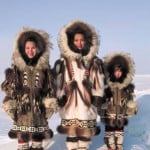3 common myths about languages, busted
As you may have noticed, I am pretty passionate about languages in general, and over the years have heard many misconceptions thrown around the place when the topic has come up in discussion. Here are three interesting linguistic myths, and why I (and many others) believe them to be myths…
 1. The Eskimo language has a hundred words for snow.
1. The Eskimo language has a hundred words for snow.
You’ve probably heard this one, and you probably believed it the first time you heard it. I know I did. It’s a very old misconception, and has even been mentioned in several text books by academics who should perhaps have known better.
The truth of the matter is, just because snow is a central part of Eskimo life, they only have around 25 words for snow, and most of those are either compound words including the Eskimo word for snow, or descriptive words. If you think of the number of words in English containing the root ‘snow’ (e.g. snowstorm, snowbound, snowshoes etc.) as well as all our many descriptive words (e.g. blizzard, powder, slush etc.), we have far more words for snow than the Eskimos do.
 2. Americans are ruining the English language.
2. Americans are ruining the English language.
Ask any Brit and they’ll tell you how Americans are butchering the Queen’s English. From the vocabulary we use, to our accents, to dropping the ‘u’ in color, to spelling words ending in -ize instead of -ise – the overall impression you’ll get is that we’re “doing it wrong”.
Well, next time a British person berates you for single-handedly ruining the English language, you might want to let them know that modern British English is just as different from Colonial English (the English everyone was speaking when Great Britain owned a quarter of the world’s landmass) as American English is. To take it one step further, American English is in many ways closer to Colonial English and its roots: color is actually from the Latin word, uh, color. Who knows why Brits added the u between the second o and the r in the first place?
Despite our thoroughly out of date British English stereotypes (e.g. “jolly good old chap”, “cor blimey guv’nor”, etc.), thanks to the ubiquity of Hollywood movies and popular TV shows like Friends, British people are far more aware of American neologisms than we are of theirs – so it’s only natural for the differences in the English variants to be more visible to Brits.
 3. Children can learn a new language easily, adults cannot.
3. Children can learn a new language easily, adults cannot.
Well, this one at least has a basis in truth. The brains of children are like sponges, soaking up new information and thirsting for more. However, that doesn’t mean that they are innately better at learning a new language.
To fully explain this would take a post a lot longer than this one, but one of the main reasons that children appear to pick up new languages faster is that of immersion: they spend most of their childhoods learning their native language, and studying at school. If an adult was able to spend the same number of hours as a child learning a language, it’s likely that they would advance far faster. Unfortunately, most adults are not in the position where they can dedicate quite so much time to their language studies.
Also, an adult’s mindset when learning a new language is often that of learning a different ‘way’ of expressing their native language. If you’re English and you’re learning French, many adults unconsciously see French as a different way of expressing English, rather than treating it as a brand new, separate language. Children are much better at immersing themselves and accepting reality for what it is, whereas adults are more likely to question what they’re told, as well as relate everything to their own experiences.
Adults are far better at learning to read and write than children – the average adult can learn a brand new alphabet in about a week, and be reading it at a fairly decent speed within a month or two. Most children take a significantly longer time to gain these skills.
So there we go – 3 myths about languages, busted wide open for all to see.
